| Article ID | Journal | Published Year | Pages | File Type |
|---|---|---|---|---|
| 5744273 | Journal of Arid Environments | 2017 | 7 Pages |
â¢Geomorphology influences plant distribution along ecotones.â¢Seedling establishment in soils of different landforms was evaluated.â¢Species differ in their ability to establish in different soils.â¢Differential establishment is consistent with species distribution in the landscape.
The influence of geomorphology on the distribution of plant communities in arid landscapes has long been recognized. However, the mechanisms behind this influence still remain unexplored in most cases. At the southern Monte - Patagonia ecotone, communities belonging to both biogeographical regions coexist, but are confined to specific landforms. Bars are dominated by Larrea divaricata, which is typical of the Monte, while topographically lower channels are dominated by Chuquiraga avellanedae, which is more related to Patagonia. We aimed to evaluate whether these species differed in their ability to establish in different landforms, thereby defining the species distribution across this ecotone. We used a greenhouse experiment to examine the role of soil from different landforms (bars and channels) and microsites (mounds and interspaces), with different levels of water availability to examine seedling establishment and growth of these two species. We recorded three-times greater establishment of Chuquiraga avellanedae than Larrea divaricata in channels and the average biomass of Chuquiraga avellanedae in channel mound soils was more than twice that in other soils. Establishment of Larrea divaricata was higher in bar soils but there was no survival in channel interspace soils. We found no overall effect of water availability. Our results indicate that species distribution in this landscape is partly a result of processes operating at early stages of plant life.
